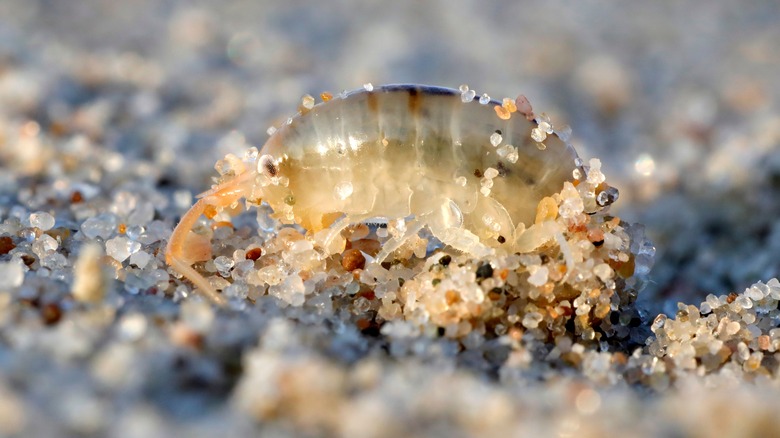Are Sand Fleas Dangerous? (And The Best Way To Avoid Them)
If you've been to the beach and stuck your hand in the wet sand near the shore, you've likely encountered wiggling sand fleas, also known as beach hoppers. Perhaps you or your little ones have even toyed with them while building sand castles or digging holes, an activity you think twice before doing. If you're unfamiliar with sand fleas, these tiny creatures have antennas, are dark in color, and feature eight legs. Interestingly, they are considered crustaceans and, for the most part, are harmless.
Nevertheless, like an average flea, they do jump. Sand fleas have also been known to bite, which can cause the skin to break into a rash. If this is the case, family physician Eric Ascher, D.O., told Prevention, "I always tell my patients after a bite, to make sure they clean the area with soap, water, and an over-the-counter antibacterial cream in an effort to prevent infection." To ease any pain, discomfort, or itchiness. Dr. Ascher also advised using aloe vera and an over-the-counter pain reliever. In short, ensure that you save room in your bag for a first-aid kid when you go to the beach.
Sand fleas are primarily nocturnal. Thus, to lessen your chances of being bitten, refrain from visiting the beach after the sun goes down or before it comes up. However, there's something else you should be aware of. A sand flea can also refer to a different critter that is not as innocuous: Tunga penetrans, a parasite.
Tunga penetrans — the treacherous sand flea
In addition to sand fleas, Tunga penetrans are also called chigoe fleas. They are common at under-the-radar beach vacation destinations like Mexico, the West Indies, South America, and Africa, to name a few. Simply put, you won't want to be bitten by a female Tunga penetrans. Unlike beach hoppers, which cause mild symptoms, female Tunga penetrans can infect unsuspecting beachgoers with Tungiasis, a skin condition that could affect the ankles, toes, and feet. For this to occur, you would come into contact with a female Tunga penetrans at the beach. However, Tunga penetrans can also be found on farms and animals.
Bites by Male Tunga penetrans, however, do not result in Tungiasis. That said, the female sand flea creates a hole in the skin, nesting itself to produce eggs. This all happens likely without the host's knowledge. As Nancy Hinkle, Ph.D., from the University of Georgia's Department of Entomology, put it (via Health), "That's the risk there: You have this lovely vacation, you get back on the plane—a couple of days later, you notice irritation on your big toe, [and] it's hurting to walk around."
Tungiasis creates painful and itchy raised white bumps with a black center. After a few weeks, the eggs and the sand flea will leave the skin. But this does not mean the individual is in the clear. The wound created by the sand flea could become infected and cause everything from gangrene to tetanus, sepsis, and more.
Treating tungiasis caused by sand fleas
If you're on vacation or have returned from your trip and believe you might have tungiasis from a sand flea, it's crucial to seek medical attention, especially if you have symptoms. These can include itchiness and swelling of the affected area. Of course, a telltale sign is the infamous raised bumps. However, tungiasis can also be mistaken for a rash or mosquito bites. Whatever the case, if you've traveled recently and noticed any of these changes in your skin, see your doctor.
If the sand flea and its eggs have not left your skin, a health professional can surgically remove them and properly disinfect the area. Note that a tetanus shot will likely also be administered. It's vital not to DIY removing the sand fleas, as this could also lead to an infection. Cryotherapy or NYDA, a drug commonly used to treat lice, might also be used against sand fleas. Antibiotics will be prescribed to prevent an infection if there is an entry wound.
Anti-itch cream and steroids may also be recommended to treat other symptoms caused by tungiasis. Are you going on vacation soon to any of the above destinations where sand fleas are commonplace? Opt for close-toed shoes to protect yourself from these not-so-friendly critters. In addition, use an insect repellant with DEET. Products containing this chemical are widely available for purchase online.

